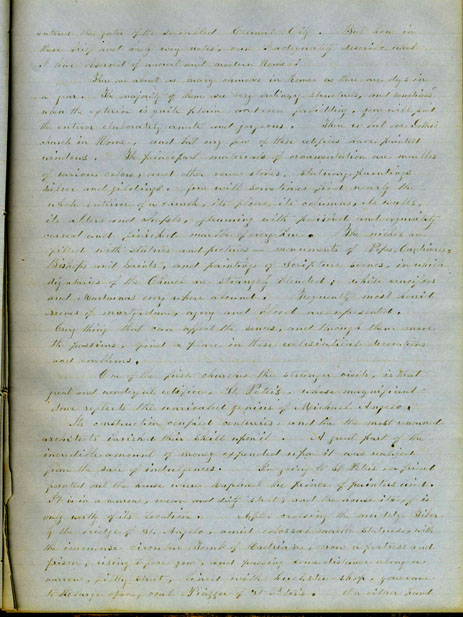Travel
Diary of Mrs. R.P. Eaton:
Europe,
Egypt, and Palestine, ca. 1857

There are about as many churches in Rome as there are days in a year. The majority of them are very ordinary structures, and sometimes when the exterior is quite plain and even forbidding, you will find the interior elaborately ornate and gorgeous. There is but one Gothic church in Rome, and but very few of these edifices have painted windows. The principal materials of ornamentation are marbles of various colors, and other rare stones, statuary, paintings, silver and gildings. You will sometimes find nearly the whole interior of a church, its floors, its columns, its walls, its alter and chapels, gleaming with polished and exquisitely carved and finished marble of every hue. The niches are filled with statues and pictures – monuments of Popes, Cardinals, Bishops and Saints, and paintings of Scripture scenes, in which dignitaries of the Church are strangely blended; while crucifixes and Madonnas everywhere abound. Frequently most horrid scenes of martyrdom, agony and blood are represented. Everything that can affect the scenes, and through them move the passions, find a place in these ecclesiastical decorations and emblems.
One of the first churches the stranger visits, is that great and wonderful edifice, St. Peter’s, whose magnificent dome reflects the unrivaled genius of Michael Angelo. Its construction occupied centuries, and the most renowned architects lavished their skill upon it. A great part of the incredible amount of money expended upon it was realized from the sale of indulgences. In going to St. Peter’s, a friend pointed out the house where Raphael the prince of painters lived. It is in a narrow, mean and dirty street, and the house itself is only worthy of its location. After crossing the muddy Tiber by the Bridge of St. Angelo, amid colossal marble statues, with the immense circular Tomb of Hadrian, now a fortress and prison, rising before you, and passing some distance along a narrow, filthy street, lined with huckster-shop, you come to the large open, oval Piazza of St. Peter’s. On either hand